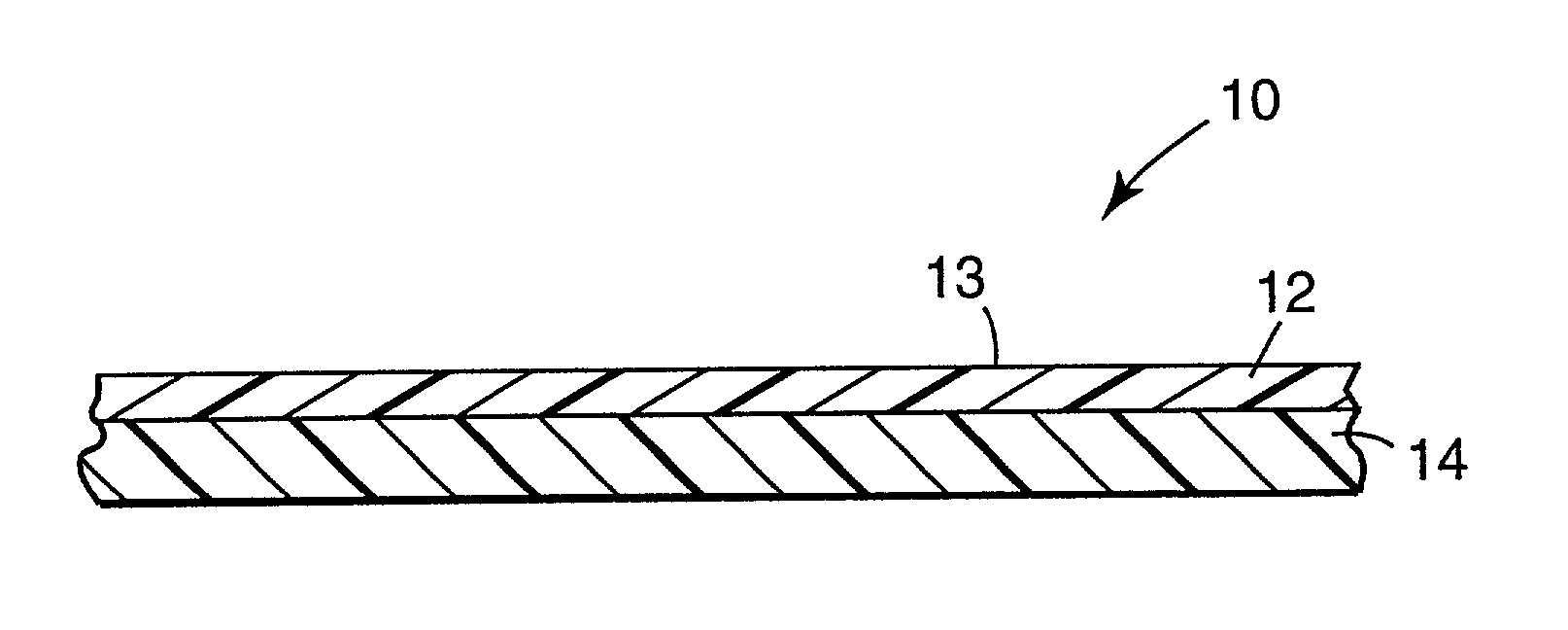Solvent inkjet ink receptive films
a technology of inkjet ink and film, applied in the field of solvent inkjet ink receptive films, can solve the problems of insufficient wetting of imaged with non-contact printing, image defects are typically, and it is not generally feasible to dilute screen printing ink
- Summary
- Abstract
- Description
- Claims
- Application Information
AI Technical Summary
Benefits of technology
Problems solved by technology
Method used
Image
Examples
examples 13-21
[0087] Three layer films were produced on a blown film line substantially as described in U.S. Pat. No. 5,721,086, except corona treatment was not used. The three extruders were set at Z1=130.degree. C., Z2=Z3=200.degree. C. and the die was set at 200.degree. C. For the image receptive layers, the modified EVA carrier resins and acrylic resins were dry blended and then fed into the extruder, except for Examples 17 and 18 for which the BYNEL 3101, ELVALOY 741, and acrylic resins were pre-compounded using a twin screw extruder, and then pelletized.
[0088] The descriptions of the blown film constructions are given in Table 4 and consist of an olefin core layer, with an adhesive prime layer on one side and an image receptive layer on the other side.
[0089] For all films below, the adhesive prime layer composition was 80 / 12 / 4 / 4 ratio of 3135B EVA / MT 5000 / ABC 5000 / UV 10407 and the adhesive prime layer was 0.5 mils (12.7 micrometers) thick.
4 TABLE 4 Image Receptive Core Total Film Layer Laye...
examples 22-23
[0093] Example 22 was a multi-layered single side printable banner produced using a conventional blown film coextrusion process substantially as described in U.S. Pat. No. 5,721,086, except corona treatment was not used. Each of the seven extruders A, B, C, D, E, F, G supplied a melt formulation to an annular die where the melts were combined to form a single molten stream consisting of seven distinct layers in a sleeve shape. The melt of extruder A formed the image receptor layer, and the melt of extruders B, C, D, E, F, G formed the substrate layers. The molten polymer sleeve was then blown to its final diameter and thickness by introducing air into the sleeve and trapping it between the die and nip rolls at the top of the blown film tower. The film sleeve was then slit into two flat film webs, and wound onto a core. The resulting sample had a thickness of about 12 mils (300 micrometers). This banner material was printed on a VUTEk 2360SC inkjet printer running at both Ultra (200 ...
PUM
| Property | Measurement | Unit |
|---|---|---|
| weight percent | aaaaa | aaaaa |
| weight percent | aaaaa | aaaaa |
| weight percent | aaaaa | aaaaa |
Abstract
Description
Claims
Application Information
 Login to View More
Login to View More - R&D
- Intellectual Property
- Life Sciences
- Materials
- Tech Scout
- Unparalleled Data Quality
- Higher Quality Content
- 60% Fewer Hallucinations
Browse by: Latest US Patents, China's latest patents, Technical Efficacy Thesaurus, Application Domain, Technology Topic, Popular Technical Reports.
© 2025 PatSnap. All rights reserved.Legal|Privacy policy|Modern Slavery Act Transparency Statement|Sitemap|About US| Contact US: help@patsnap.com


